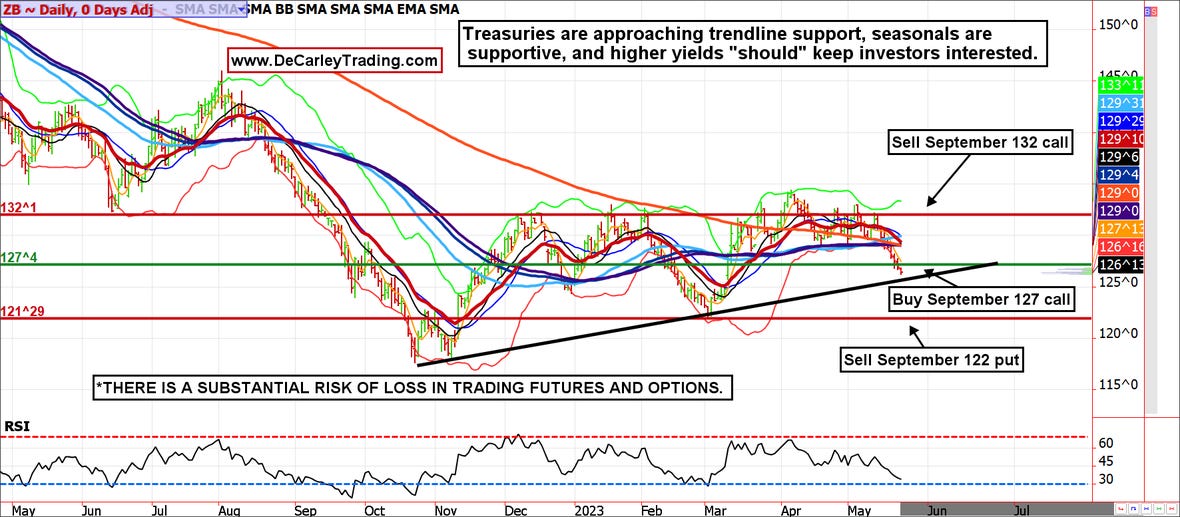Strategy Trade Idea...Bullish September T-Bond Option Spread
2022 was the worst year for Treasury investors since the late 1800s
Treasuries have a history of comebacks
2022 was the worst year for Treasury investors since the late 1800s. Thus far, 2023 has been slightly better, but prices have yet to recover meaningfully. Debt default talks and higher stocks are keeping bond bulls on their back foot, but with trendline support coming into play and bullish seasonality, it seems like an opportune time to try to play the upside. After all, US yields are attractive relative to overseas securities with a lower inflation rate and lower default risk (hopefully). All of these things should keep the market from melting down.
We like using a bull call spread with a naked put in the September options. This allows traders to participate in the upside while leaving several points in breathing room on the downside. However, it does come with unlimited downside risk.
Alternative Strategy
If you are looking for limited risk, the 127/132 vertical call spread can be bought for about $1500 (that represents the maximum risk before transaction costs). Another idea would be to buy the 10-year note 116 call for a little over $1,000. If you prefer futures, you could sell the Micro 10-year note (symbol 10Y) which trades in yield rather than price, or even buy the full-sized 10-year note future.
BULLISH SEPTEMBER 30-YEAR BOND SPREAD
BUY SEPTEMBER ZB 127 CALL
SELL SEPTEMBER ZB 132 CALL
SELL SEPTEMBER ZB 122 PUT
Cost = This spread costs about 13 ticks or $203 plus transaction costs
Margin = $3940
Risk = Unlimited below 122
Maximum Profit = $4,750, if held to expiration and the 30-year bond is above 132. However, a worthy profit target would be about $2,000/$2,500 in the coming months as opposed to holding all the way to expiration
Expiration = August 25th
DTE = 94
Zaner360 symbols:
OZBU23 C127, OZBU23 C132, AND OZBU23 P122
*There is a substantial risk of loss in trading futures and options. There are no guarantees in speculation; most people lose money trading commodities. Past performance is not indicative of future results.
Due to time constraints and our fiduciary duty to put clients first, the charts provided in this newsletter may not reflect the current session data.
Seasonality is already factored into current prices, any references to such does not indicate future market action.
**There is substantial risk of loss in trading futures and options.** These recommendations are a solicitation for entering into derivatives transactions. All known news and events have already been factored into the price of the underlying derivatives discussed. From time to time persons affiliated with Zaner, or its associated companies, may have positions in recommended and other derivatives. Past performance is not indicative of future results. The information and data in this report were obtained from sources considered reliable. Their accuracy or completeness is not guaranteed. Any decision to purchase or sell as a result of the opinions expressed in this report will be the full responsibility of the person authorizing such transaction. Seasonal tendencies are a composite of some of the more consistent commodity futures seasonals that have occurred over the past 15 or more years. There are usually underlying, fundamental circumstances that occur annually that tend to cause the futures markets to react in similar directional manner during a certain calendar year. While seasonal trends may potentially impact supply and demand in certain commodities, seasonal aspects of supply and demand have been factored into futures & options market pricing. Even if a seasonal tendency occurs in the future, it may not result in a profitable transaction as fees and the timing of the entry and liquidation may impact on the results. No representation is being made that any account has in the past, or will in the future, achieve profits using these recommendations. No representation is being made that price patterns will recur in the future.






